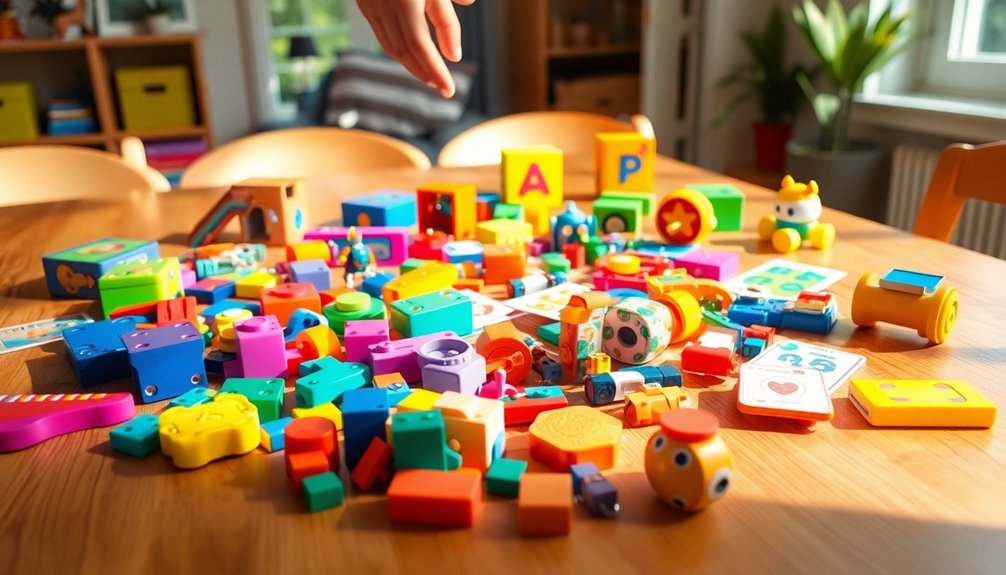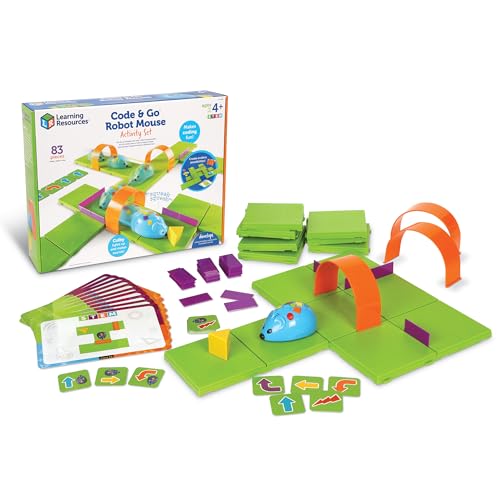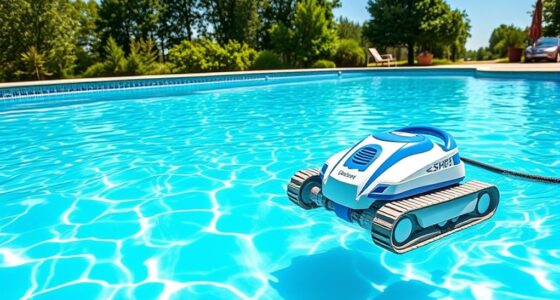If you’re looking for fun and engaging coding toys for kids, I highly recommend the Makeblock mBot2 Coding Robot and the WhalesBot D3 Pro 12-in-1 Kit. These toys make learning STEM concepts exciting while encouraging creativity and problem-solving. The Snap Circuits Jr. SC-100 is another great option, introducing basic circuitry in an interactive way. Plus, the Learning Resources Code & Go Robot Mouse is perfect for younger kids. Want to explore even more amazing options? Additionally, the Osmo Genius Starter Kit offers a unique blend of physical and digital play, making it one of the best educational toys for kids who enjoy hands-on learning experiences. Another fantastic choice is the LEGO Boost Creative Toolbox, which combines building with coding to foster both creativity and analytical skills. With these toys, children will not only have fun but also develop critical thinking and technical skills that will serve them well in the future.
Key Takeaways
- The Makeblock mBot2 Coding Robot offers hands-on coding experiences with sensors, promoting creativity and problem-solving skills in kids aged 8 and up.
- Introductory coding toys like Learning Resources Code & Go Robot Mouse engage children aged 4 and up with screen-free, interactive learning experiences.
- Creative building kits such as WhalesBot D3 Pro 12-in-1 provide extensive hands-on STEM learning through building multiple robot models with 388 pieces.
- Many coding toys, like Botley The Coding Robot, facilitate STEM education by introducing basic coding concepts in a fun, engaging manner for young learners.
- Numerous coding toys feature user-friendly setups and multiple components, enhancing interactivity and making learning enjoyable for children of various ages.
Makeblock mBot2 Coding Robot for Kids
If you're looking for a coding toy that truly engages kids aged 8-12, the Makeblock mBot2 Coding Robot is an excellent choice. This robot supports both Scratch and Python programming, allowing kids to explore coding in a fun way. With over 10 advanced sensors, it can follow lines and avoid obstacles, adding to the excitement. I love how easy it is to assemble—just about 30 minutes with simple guides! Plus, it promotes STEM education through interactive activities. The mBot2's robust construction and community support make it an ideal gift that sparks creativity and a lasting interest in technology.
Best For: Kids aged 8-12 who are interested in learning coding and robotics in a fun and engaging way.
Pros:
- Supports both Scratch and Python programming, catering to different skill levels.
- Includes a variety of advanced sensors for interactive tasks like line-following and obstacle avoidance.
- Offers excellent customer support and a large community for advice and resources.
Cons:
- Some users recommend additional tutorials for programming to enhance the learning experience.
- Limited playtime of up to 5 hours may require frequent recharging.
- Expandable modules may require additional investment for extended functionality.
Makeblock mBot Robot Kit for Kids Ages 8-12
The Makeblock mBot Robot Kit is an excellent choice for kids ages 8-12 who are enthusiastic to plunge into the world of robotics and coding. With easy assembly in just 15 minutes, it introduces children to electronics and programming through engaging hands-on experiences. They can explore functions like remote control, line-following, and obstacle avoidance, using Scratch and Arduino languages. Plus, it connects with over 100 electronic modules and 500 parts, ensuring endless possibilities. While some may find the software a bit challenging, the supportive online community and resources make troubleshooting a breeze. It's a fantastic gift that sparks creativity and learning!
Best For: The Makeblock mBot Robot Kit is best for kids ages 8-12 who are eager to learn about robotics and coding through interactive and hands-on experiences.
Pros:
- Encourages creativity and problem-solving through robotics and programming.
- Easy assembly within 15 minutes makes it accessible for beginners.
- Compatible with over 100 electronic modules and 500 parts, allowing for diverse projects.
Cons:
- Some users may find the software and documentation challenging to navigate.
- Requires additional batteries that are not included, which may be inconvenient.
- Experiences may vary based on prior knowledge in programming and electronics.
WhalesBot D3 Pro 12-in-1 Coding Robot Kit for Kids
Looking for the perfect coding toy for your child aged 6 to 8? The WhalesBot D3 Pro 12-in-1 Coding Robot Kit is a fantastic choice! With 388 pieces, your child can build 12 different robot models while developing creativity and problem-solving skills. The screen-free coding pad makes programming easy and fun, encouraging hands-on STEM learning. Plus, the included story guide books turn coding into an exciting adventure. With an average rating of 4.5 stars, parents love the quality and clarity of the instructions. Watch your child engage in a world of interactive learning with this amazing kit!
Best For: The WhalesBot D3 Pro 12-in-1 Coding Robot Kit is best for children aged 6 to 8 who are interested in hands-on STEM learning and creative problem-solving.
Pros:
- Encourages creativity and critical thinking through building and programming 12 different robot models.
- Screen-free coding pad promotes a healthier learning environment.
- Engaging story guide books make the learning process fun and adventurous.
Cons:
- Some users have reported connectivity issues with the Bluetooth functionality.
- A few customers mentioned missing instructions for certain robot configurations.
- The kit may be complex for some younger users without adult assistance.
Snap Circuits Jr. SC-100 Electronics Exploration Kit
Designed for curious minds aged 8 and up, the Snap Circuits Jr. SC-100 Electronics Exploration Kit has captivated my attention. With over 30 color-coded components, I can build more than 100 projects, from musical doorbells to clap-controlled sounds. The hands-on learning experience helps me grasp basic circuitry concepts while progressing through varying project complexities. I appreciate the included project manual that guides me step-by-step. Plus, I can upgrade to more advanced kits when I'm ready for a challenge. It's no wonder it's received awards and boasts a stellar 4.8-star rating—Snap Circuits makes learning about electronics super fun!
Best For: The Snap Circuits Jr. SC-100 Electronics Exploration Kit is best for children aged 8 and older who are interested in learning about electronics and circuitry through hands-on projects.
Pros:
- Engages children in STEM learning with over 100 project possibilities.
- Encourages progressive skill development through varying project complexities.
- High customer satisfaction with a 4.8 out of 5-star rating.
Cons:
- Requires two AA batteries that are not included in the kit.
- Limited to basic projects unless upgraded with additional kits.
- May be too simplistic for older children or those with prior experience in electronics.
Learning Resources Code & Go Robot Mouse Activity Set for Kids
For young aspiring coders aged 4 and up, the Learning Resources Code & Go Robot Mouse Activity Set is a fantastic introduction to the world of programming. This screen-free toy features 83 pieces, including maze grids and coding cards, making it perfect for hands-on learning. I love how it enhances critical thinking and problem-solving skills while teaching coding fundamentals. The interactive robot mouse, Colby, lights up and responds to colorful buttons, keeping kids engaged. It's easy to use, though younger children might need a bit of help. Overall, it's an excellent gift that fosters creativity and STEM skills.
Best For: The Learning Resources Code & Go Robot Mouse Activity Set is best for young children aged 4 and up who are interested in coding and STEM activities.
Pros:
- Enhances critical thinking and problem-solving skills through hands-on activities.
- Engaging interactive robot mouse that lights up and responds to programming.
- Versatile for various learning environments, including home and classrooms.
Cons:
- Younger children may require assistance with assembly and operation.
- Some concerns about the durability of the robot mouse's movement and wheel functionality.
- Battery not included, requiring additional purchase for operation.
Snap Circuits Teach Tech Mech 5, Mechanical Coding Robot
The Snap Circuits Teach Tech Mech-5 Mechanical Coding Robot stands out as an excellent choice for budding engineers aged 10 and up. It teaches essential mechanical engineering principles and coding basics while allowing kids to create engaging projects like throwing or drawing. The assembly process requires patience with its tiny parts, but the clear instructions make it manageable. I've noticed that kids really enjoy the challenge, enhancing their critical thinking skills. Just be cautious, as some parts can be fragile. Overall, it's a fantastic educational toy that sparks creativity and interest in STEM fields!
Best For: The Snap Circuits Teach Tech Mech-5 is best for children aged 10 and up who are interested in mechanical engineering and coding.
Pros:
- Encourages hands-on learning and enhances critical thinking skills.
- Clear assembly instructions make the building process manageable and enjoyable.
- Engaging projects allow kids to explore various mechanical functions like throwing and drawing.
Cons:
- Some plastic parts may be fragile, raising concerns about durability.
- Assembly can be challenging, requiring adult assistance for younger children.
- The robot operates loudly, which may be distracting in quiet environments.
Learning Resources Botley The Coding Robot (45 Pieces)
Botley The Coding Robot is an excellent choice for kids aged 5 and up who are excited to plunge into the world of coding without the distractions of screens. With 45 pieces, including a remote programmer and coding cards, it's designed to spark creativity and promote STEM learning. I love how it teaches kids problem-solving as they create obstacle courses and navigate with Botley. The screen-free experience encourages hands-on engagement, and the robot can follow commands up to 80 steps! Though battery consumption can be high, it's a fantastic gift for young coders thrilled to explore technology.
Best For: Kids aged 5 and up who are eager to learn coding in a fun, screen-free environment.
Pros:
- Easy setup and operation, allowing kids to start coding quickly.
- Engaging sounds and lights enhance interaction and make learning enjoyable.
- Includes multiple coding challenges and activity components that promote creativity.
Cons:
- Limited playtime for multiple children at once, making it more suited for individual play.
- High battery consumption, potentially requiring frequent replacements.
- Some features may need precise setup to function effectively, which can be challenging.
Makeblock mBot Robot Kit for Kids Ages 8-12
A fantastic choice for budding engineers and tech enthusiasts ages 8 to 12, the Makeblock mBot Robot Kit offers an engaging introduction to robotics and coding. With easy assembly in just 15 minutes, kids immerse themselves in electronics and programming using Scratch and Arduino. Its fun features include remote control, line-following, and obstacle avoidance. The kit connects to over 100 electronic modules and is compatible with LEGO, ensuring endless creativity. While some users find the software a bit challenging, forums provide helpful support. Overall, this kit makes for a fantastic gift, encouraging learning through play and exploration.
Best For: Kids ages 8 to 12 who are interested in learning about robotics and coding through hands-on activities.
Pros:
- Engaging Learning Experience: Provides a fun introduction to electronics and programming with easy assembly and interactive software.
- Versatile and Expandable: Compatible with over 100 electronic modules and LEGO, allowing for endless creativity in projects.
- Positive User Feedback: High customer ratings and satisfaction regarding its educational value and quality.
Cons:
- Software Complexity: Some users find the programming software and documentation challenging to navigate.
- Battery Requirements: Requires additional batteries for the robot and remote control, which are not included in the kit.
- Learning Curve: Experiences may vary based on prior knowledge in programming and electronics, potentially making it less accessible for complete beginners.
ELEGOO UNO R3 Smart Robot Car Kit V4 for Arduino Robotics
Designed specifically for kids aged 8-16, the ELEGOO UNO R3 Smart Robot Car Kit V4 stands out as an engaging educational tool for budding engineers and programmers. It includes 24 modules like obstacle avoidance and line tracing sensors, making robotics fun. The assembly is straightforward, thanks to modified ports and HD instructions, although beginners might need some guidance. I love that it offers multiple control options, including Bluetooth and an app for DIY remote programming. While some users faced minor challenges with assembly and IR range, the overall experience is rewarding. This kit ignites creativity and curiosity in young minds!
Best For: The ELEGOO UNO R3 Smart Robot Car Kit V4 is best for kids aged 8-16 who are interested in learning programming, electronics, and robotics.
Pros:
- Sturdy parts that ensure reliable operation.
- Plug-and-play assembly with no soldering required, making it user-friendly.
- Multiple control options, including Bluetooth and app programming, enhance interactivity.
Cons:
- Small parts may require good hand control during assembly.
- Potential wheel misalignment can occur, affecting performance.
- The IR remote control has a limited range, which may hinder usability.
Educational Insights PYXEL Coding Robots for Kids
The Educational Insights PYXEL Coding Robot is perfect for kids enthusiastic to plunge into the world of coding, thanks to its user-friendly interface that supports both Blockly and Python. With a simple setup and built-in tutorials, kids can start coding in minutes, even without an internet connection. The robot performs actions, changes colors, and responds to touch and sound, making learning interactive and engaging. While some users report durability issues, the educational value and fun factor shine through. Overall, it's a great entry point into coding, though I'd recommend keeping an eye on potential technical hiccups.
Best For: Kids eager to learn coding through interactive play and exploration in a user-friendly environment.
Pros:
- Encourages STEM learning through drag-and-drop coding and programming concepts.
- Simple setup with built-in tutorials allows for quick and easy use.
- Engaging features like color changes, sounds, and responsive sensors enhance the learning experience.
Cons:
- Reports of durability issues, with some lights and sensors failing prematurely.
- Mixed experiences with customer support and return processes for faulty units.
- Performance may vary across devices, with less effectiveness noted on mobile devices.
Learning Resources STEM Explorers Pixel Art Challenge (402 Pieces)
For kids ages 5 and up who love puzzles and creative challenges, the Learning Resources STEM Explorers Pixel Art Challenge is an excellent choice. With 402 pieces, including colorful pixel cubes and challenge cards, it engages young minds in crafting 2-D pixel art inspired by Minecraft and retro games. I love how it promotes STEM learning while developing critical thinking and fine motor skills. The interactive challenges keep kids entertained for hours without screens. Plus, it's safe and easy to assemble, making it perfect for home or classroom use. Just be mindful of the small pieces during cleanup!
Best For: Children ages 5 and up who enjoy puzzles and creative challenges.
Pros:
- Engaging STEM learning: Promotes critical thinking and problem-solving skills through interactive challenges.
- Safe and easy to use: Foam cubes are a safe alternative, making it suitable for younger children.
- Screen-free fun: Keeps kids entertained for hours without the need for electronic devices.
Cons:
- Small parts hazard: Contains small pieces that may pose a choking risk for younger children.
- Potential for loss: Foam cubes can be easily lost, requiring careful handling and cleanup.
- Limited design flexibility: Some users recommend more pieces of each color and a second board for collaborative play.
Sphero Mini Coding Robot Ball (Green)
Perfect for young tech enthusiasts, the Sphero Mini Coding Robot Ball (Green) offers an engaging introduction to robotics and coding. About the size of a ping pong ball, it connects via Bluetooth and comes loaded with colorful LED lights and sensors. Using the Sphero Edu app, I can create games or code with drag-and-drop blocks or JavaScript. Plus, it's a blast as a game controller for arcade-style games! With accessories like traffic cones and bowling pins, it inspires creativity and encourages hands-on learning, making it a fantastic gift for kids keen to explore technology and coding.
Best For: The Sphero Mini Coding Robot Ball (Green) is best for kids aged 8 and up who are interested in robotics and coding.
Pros:
- Engaging learning tool that combines coding with hands-on play, fostering creativity and critical thinking.
- Durable design that can withstand rough play, making it suitable for various environments.
- Versatile gameplay options including arcade-style games and customizable coding opportunities.
Cons:
- Limited battery life with only about 45 minutes of playtime per charge.
- Bluetooth connectivity issues can cause interruptions during gameplay.
- Performance challenges on thick carpets, which may hinder movement and control.
Playz My First Coding & Computer Science Kit
Looking for a fun way to introduce your child to the world of coding? The Playz My First Coding & Computer Science Kit is perfect! Designed for kids ages 6 and up, it teaches essential concepts like binary code and algorithms through hands-on activities. With over 30 tools and a colorful lab guide, your child can create binary necklaces and solve mystery mazes. Parents rave about how engaged their kids are, and I've noticed improvements in critical thinking skills too. Plus, with a 4.3-star rating, it's clear that many families find this kit a hit!
Best For: The Playz My First Coding & Computer Science Kit is best for children ages 6 and up who are curious about coding and computer science concepts.
Pros:
- Engaging hands-on activities that enhance learning and creativity.
- Encourages critical thinking and problem-solving skills.
- Positive feedback from parents on children's enjoyment and understanding of coding.
Cons:
- May require adult supervision for younger children during some activities.
- Some parents feel the instructions could be clearer for certain projects.
- Limited scope of advanced coding concepts, suitable mainly for beginners.
Learning Resources Coding Critters Go Pets Scrambles the Fox Interactive STEM Coding Toy for Kids
The Learning Resources Coding Critters Go Pets Scrambles the Fox is an engaging choice for young learners enthusiastic to explore coding concepts. This screen-free toy captivates kids aged four and up, featuring Scrambles, an interactive coding pet. With 14 pieces and a 12-page storybook, it promotes sequential thinking as children guide Scrambles along paths. I love how it fosters patience while reinforcing cognitive skills through two-sided puzzles. Kids often find it fun and easy to use, making it a hit in group settings. Despite some concerns about durability, it's a fantastic gift that cleverly blends learning and play.
Best For: Young learners aged 4 and up who are eager to explore coding concepts through interactive play.
Pros:
- Engaging: Captivates children's attention, providing hours of fun and educational play.
- Skill Development: Encourages sequential thought, cognitive skills, and emotional development through problem-solving challenges.
- Social Play: Ideal for group settings, making it a great choice for playdates or gatherings.
Cons:
- Durability Concerns: Some users reported defects, which can impact overall enjoyment.
- Limited Replayability: A few reviews mentioned a desire for more track tiles to sustain interest over time.
- Customer Service Issues: Concerns were raised regarding responsiveness to product defects.
Learning Resources Botley The Coding Robot 2.0 Activity Set for Kids
For kids aged 5 and up, the Learning Resources Botley The Coding Robot 2.0 Activity Set is an engaging way to introduce coding concepts in a fun, screen-free environment. With 78 pieces, including direction cards and interactive cubes, Botley lets kids explore coding through music, lights, and movements. I love how it promotes critical thinking and adapts to my child's skill level. The included activity book guides us in creating challenges and mazes. Plus, it's durable, ensuring long-term use. Overall, Botley's a fantastic gift for nurturing STEM skills while keeping kids entertained and engaged.
Best For: The Learning Resources Botley The Coding Robot 2.0 Activity Set is best for children aged 5 and up who are interested in exploring coding concepts through interactive play.
Pros:
- Encourages critical thinking and problem-solving skills in a fun, engaging way.
- Provides a variety of coding interactions that grow with the child's development.
- Durable and versatile components allow for endless creative challenges and mazes.
Cons:
- Some users have reported issues with customer service and product defects.
- Initial guidance may be needed for younger children to fully utilize the set.
- Connectivity problems have been noted by a few customers, impacting user experience.
Factors to Consider When Choosing Coding Toys for Kids

When picking coding toys for kids, I always consider their age and learning objectives first. It's essential to find toys that are easy to assemble and support the right programming languages. Plus, I look for interactive features that keep kids engaged and excited about learning.
Age Appropriateness
Choosing the right coding toy for kids means paying close attention to age appropriateness. I've found that many toys are specifically designed for certain developmental stages. For younger kids (ages 4-6), coding toys often introduce basic concepts and encourage physical interaction. As kids grow (ages 8 and up), they can tackle more complex programming languages like Scratch or Python. It's key to guarantee the toy's complexity matches your child's prior knowledge and skills. Age-specific toys include challenges and materials that align with cognitive abilities, so they're engaging without being overwhelming. By selecting age-appropriate coding toys, you'll foster a love for learning while keeping the experience fun and rewarding for your child.
Learning Objectives
Understanding the learning objectives behind coding toys is essential to selecting the right one for your child. Look for toys that promote fundamental programming concepts like sequencing, loops, and conditionals. These elements help kids develop critical thinking and problem-solving skills. Additionally, engaging in hands-on activities can enhance fine motor skills and spatial awareness, which are crucial for cognitive growth.
Toys that incorporate STEM principles offer a thorough learning experience that aligns with educational standards. I find that progressive learning paths allow children to build on their skills over time, making them suitable for various ages and experience levels. Finally, interactive storytelling elements can spark creativity and imagination, making coding relatable and more engaging for kids.
Ease of Assembly
While selecting coding toys for kids, considering the ease of assembly can make a huge difference in the overall experience. I've found that many coding toys come with straightforward assembly processes, often taking just 15 to 30 minutes. This means kids and parents can jump into fun together right away. Most kits provide clear, step-by-step instructions, making it easy for anyone, even those without experience, to put them together. I also appreciate toys with color-coded components and snap-together designs, which minimize mistakes. However, some kits might need extra tools or specific techniques, so adult help may be necessary. Ultimately, choosing toys that are easy to assemble lets kids focus on coding sooner, enhancing their learning adventure.
Programming Languages Supported
When exploring coding toys for kids, it's essential to take into account the programming languages they support, as this can greatly influence your child's learning experience. Different toys cater to various age groups and skill levels, with block-based languages like Scratch being perfect for younger children. These languages make coding concepts more accessible without the intimidating syntax of text-based languages. For older kids, toys that incorporate Python or Arduino allow for more complex projects, fostering deeper programming skills. I recommend looking for toys that provide a progression from beginner to advanced languages. This way, as your child's skills grow, they can continue to learn and stay engaged in their coding journey.
Interactive Features
Interactive features in coding toys can make a world of difference in your child's learning experience. When kids can control actions like movement or sound, they're more engaged and excited about learning. I've noticed that toys with storytelling elements make coding relatable and fun, encouraging kids to tackle narrative-driven challenges. Features like sensors for obstacle detection or line-following capabilities really bring coding concepts to life, promoting critical thinking and problem-solving skills. Customizable programming options, like drag-and-drop coding, cater to various skill levels, helping children grasp coding fundamentals. Plus, toys that offer multiple interaction modes—like responding to commands or completing challenges—keep kids interested and facilitate deeper learning over time. Choosing toys with these features can truly enhance their educational journey.
Durability and Quality
Durability is an essential factor to take into account when selecting coding toys for kids. I always look for toys made from high-quality materials, as younger children tend to handle them roughly. It's important to assess the weight and sturdiness; while lighter toys are easier to manipulate, they can tip over or break more easily. I also pay attention to user feedback—if a toy has a rating above 4 stars, that often indicates it's built to last. Additionally, I prefer toys that come with replaceable parts or a warranty, which shows the manufacturer's confidence in their product. Finally, I check for safety certifications to guarantee the toy can endure typical play conditions without failing.
Support Resources Available
Choosing the right coding toy for your child isn't just about the toy itself; it's also essential to take into account the support resources available. Many coding toys come with extensive support, including step-by-step tutorials and interactive software that make learning easier. I've found that online communities are invaluable, where users share tips and project ideas, enhancing the overall coding experience. Some kits even include free companion apps that receive regular updates to keep things fresh and engaging. User-friendly instruction manuals cater to both kids and parents, simplifying assembly and initial coding. Plus, reliable customer service with quick response times means you won't be left in the dark if questions arise. These resources can truly make a difference!
Frequently Asked Questions
What Age Group Is Best Suited for Coding Toys?
When it comes to coding toys, I believe the best age group to start is around 5 to 8 years old. At this stage, kids are curious and enthusiastic to learn. They can grasp basic concepts through play, which makes it enjoyable for them. I've seen how engaging these toys can be for younger kids, fostering their creativity and problem-solving skills. It's amazing to watch their confidence grow as they explore coding!
Do These Toys Require Prior Coding Experience?
Imagine diving into a magical world where coding becomes as easy as pie! You might be wondering if these coding toys need any prior experience. The great news is, they don't! These toys are designed for everyone, whether you're a beginner or a coding wizard. They guide you through fun activities that teach the basics without overwhelming you. So, you can jump right in and start creating amazing things without any worries!
Can Coding Toys Be Used for Group Activities?
Absolutely, I've found that coding toys can be great for group activities! When I use them in a classroom or at home, kids often collaborate, sharing ideas and solving problems together. It's amazing to see them communicate and strategize as they tackle coding challenges. Not only do they learn coding skills, but they also develop teamwork and social skills. I love watching their excitement when they create something as a group!
Are These Toys Compatible With Smartphones or Tablets?
Imagine a world where toys come alive with the tap of a screen! I've found that many coding toys are indeed compatible with smartphones and tablets. They often sync seamlessly, allowing kids to explore code through interactive apps. I've seen kids light up as they connect their devices, enhancing their play experience. Just check the specifications before purchasing to verify compatibility, but rest assured, many options are out there waiting to be discovered!
How Can I Assess My Child's Progress With Coding Toys?
To assess my child's progress with coding toys, I regularly observe their problem-solving skills and creativity during play. I'll ask them to explain their thought process and the steps they took to complete tasks. I also keep track of the challenges they tackle over time. Additionally, I look for improvements in their ability to debug errors and grasp new concepts. This way, I can see how much they've learned and grown.
Conclusion
In choosing the best coding toys for kids, remember that fun and learning go hand in hand. Whether it’s building with robots, programming games, or exploring electronics, each toy offers a unique way to spark creativity and critical thinking. By engaging with these toys, kids not only develop essential coding skills but also gain confidence and problem-solving abilities. So let’s inspire curiosity, foster innovation, and make learning an exciting adventure for our young ones! In addition to honing technical skills, the best educational toys for kids encourage collaboration and communication, allowing children to work together on projects and share ideas. As they navigate challenges and success, they learn the importance of teamwork and perseverance. By selecting toys that blend fun and education, we can create an enriching environment that prepares them for future opportunities in technology and beyond. Furthermore, it’s essential to choose the best educational toys for kids that cater to various interests and skill levels, ensuring that every child finds something that captivates their attention. These toys not only serve as a gateway to learning about coding and technology but also encourage exploration in fields like science, engineering, and mathematics. By providing diverse options, we can help nurture a well-rounded skill set that empowers our children to thrive in a rapidly evolving world.






















